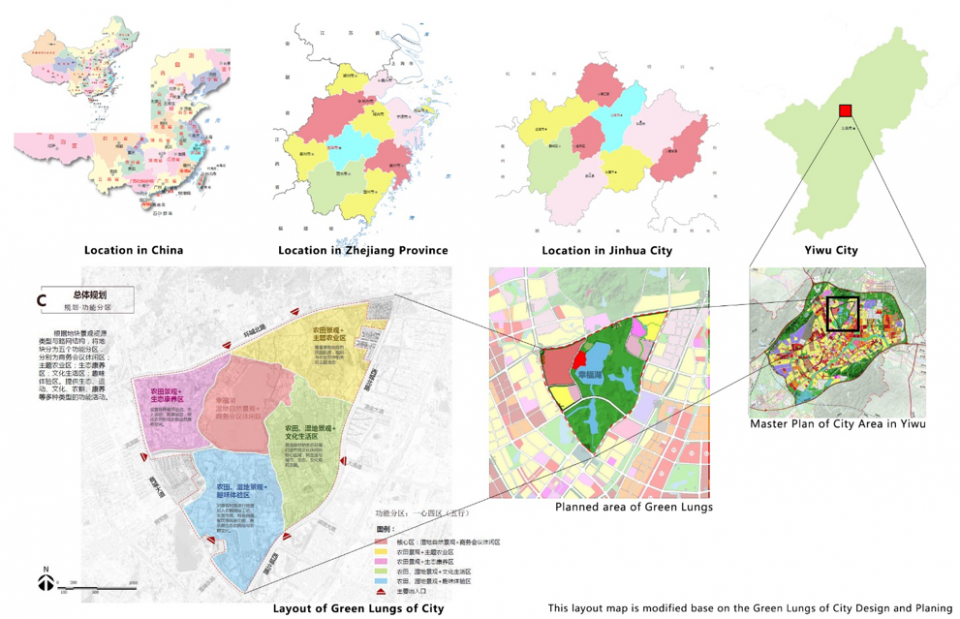
Biogeographic region: Humid Continental/North China Plain
Surface area: 8.4 km2 (840 ha)
Country: China
Region/Province: Yiwu, Zhejiang Province, China (code of Administrative boundary: 330782)
Yiwu City is located in the east of China, in central Zhejiang Province and has a metropolitan area of 1105.46 km2. The built-up area of Yiwu City comprised 108.02 km2 in 2019 and the urbanisation rate of Yiwu reached 77.6%. The permanent resident population in Yiwu counts 1.31 million inhabitants. Yiwu City is famous worldwide because of the well-developed small commodities international trade. It attracts many buyers from all around the world, more than 50,000 customers visit Yiwu Market every day. As an international trade city, Yiwu experienced large population mobility and rapid urbanisation. However, in the built-up area, the ratio of greenspace is 23.34%, while the urban parks per capita comprise only 7.82 m2. Thus, the current urban greenspace in the built-up area failed to meet the demands of residents in the city. Rapid urbanisation also has a negative influence on the city environment.
To create more green space for residents in Yiwu, as well as to mitigate the environmental pressures and improve the city resilience, the Municipal Government in Yiwu has planned to create ‘green lungs of the city’ in 2006 (s. Master Plan of Yiwu), and finally launched the Green Lungs of the City project (GLCP) in 2019, which planned to build a forest-wetland ecological park in the city central area. The planning area of GLCP is 8.4 km2.
The aims of the Green Lungs of the City Project are to build a big botanical garden for the city, create a forest-wetlands park and develop an agricultural park for citizens. GLCP uses urban forest and trees, as well as wetlands as Nature-based Solutions to promote the sustainable development of the city and to provide multiple ecosystem services for human beings in a highly urbanised area.
Objectives further include:
- Improving the green and blue landscape connectivity in an urbanised area, which is good for biodiversity conservation and water purification;
- Providing health and wellbeing benefits gained through the use of the recreation facilities;
- Allowing for educational facilities for local residents and visitors.
PRINCIPLE UF-NBS (Urban Forests as Nature-Based Solutions) ACTION(S)
Provision of new infrastructure/facilities:
- Reforestation and afforestation, including forest plantations
- Restoration of wastelands and wetlands/ponds
- Improvement of urban forest and wetlands landscape connectivity by creating the ecological corridors
- Conserve plants around reservoirs to improve the water quality
- Remove the dilapidated buildings and reforested
- Protect native tree species
- Create a green way for bicycling
OTHER PRINCIPLE NBS ACTION(S) – non-UF
- Build new public infrastructures (e.g. roads, toilets)
- Recreational and environmental educational activities (e.g., workshops for urban birds, bees or butterfly biodiversity, as well as native tree species, based on the botanic garden and wetlands park)
- Develop the cultural tourism industry (e.g. play yard or playground for experiencing the agricultural activities, catering services), eco-agricultural industrialisation, health industry (e.g. green care)
- Increased cultural richness and biodiversity
- Changing image of the urban environment
- Creation of green jobs relating to construction & maintenance of NBS
- Improve water quality
- Increase accessibility to green open spaces
- Increase well-being
The Public-Private-Participation in the Green Lungs of the City project has improved the efficiency and effectiveness of the project in an urbanised area. Despite the ecosystem services (e.g. biodiversity conservation) provided by increased urban green and blue spaces, GLCP will contribute to improve the citizens’ participation in environmental protection. As it is an ongoing project, this project will be a good field lab for UF-NBS (Urban Forests as Nature-Based Solutions) (e.g. during the progress of implementation and management).
City, regional general funds:
The local government provided very limited funding to launch GLCP (e.g. commissioned the Beijing Beilin Landscape Architecture Institute Co. Ltd. to develop the design and planning)
Private sector investment:
Non-government investment also exists, for various economical purposes such as tourism.
Other:
This project was funded by the state-owned company: Yiwu City Investment and Construction Group Co., Ltd.
- Tree and forest plantations
- Tree rows
- Riverbank green
- Ornamental trees
- Bioswales with trees and constructed wetlands
- Choice of plants
Yiwu Natural Resources and Planning Bureau
Yiwu, Zhejiang Province, China
Tel: + 86 0579-85589088
Further information
The compilation of this case study description has been funded by the Horizon 2020 CLEARING HOUSE project. This project has received funding from the European Union’s Horizon 2020 research and innovation programme under grant agreement No 821242.
- 3. Good Health and Well-being
- 11. Sustainable Cities and Communities
